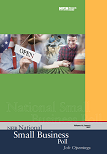Job Openings
·
One-quarter of small employers have an
open position they are currently trying to fill (Q#1).
·
The majority of
small employers without a current open position had a job vacancy within the last
12 months, 48 percent within the last six months (Q#2).
·
Just over half (56 percent) of the job
openings were full-time positions while 44 percent were part-time (Q#3).
·
About one-quarter of current and
recently filled open positions were seasonal in nature; 71 percent were not
(Q#4). Smaller firms were far more likely to have seasonal job vacancies than larger
firms (29% compared to 11%).
·
About half of the vacant jobs were
filled within two weeks and another 20 percent within two to four weeks (Q#5).
Some open positions though took longer with 12 percent taking 1 to 3 months to
fill and 10 percent took more than three months.
·
While most small business owners pay all of their employees above the federal minimum wage, about
44 percent of small employers have an employee with a salary less than $12.00.
·
The majority (57 percent) of small
employers keep their employees’ I-9 forms for more than two years, another 9
percent retain copies for less than two years (Q#21).
·
About one-quarter (26 percent) of small
employers found the lack of job-specific or occupational skills a typical
problem among applicants, and it was an occasional problem for another 40
percent of owners (Q#16A).
·
A lack of social or people skills was a
typical applicant problem for 14 percent of small employers, and an occasional
problem for 45 percent of them (Q#16C).
·
About half (47 percent) of small
employers said that a two-year phased-in federal minimum wage increase to $15.00
would negatively impact their business (Q#26).
·
Of those small employers reporting that
a $15.00 minimum wage would negatively impact their business, 85 percent
anticipate that they would have to increase the price of their goods and/or
services, passing on some of that cost to the consumer. And 74 percent reported
that they would absorb wage increases through lower earnings.
·
Fifty-eight percent anticipated an
increased use of less expensive or part-time workers in response to a higher
minimum wage, 69 percent would not fill an open position, 63 percent would
reduce employees’ hours, and 62 percent would reduce the number of employees
working for them.
·
Eighteen percent of small employers
reporting that they would be negatively affected said that they would have to
raise wages of those earning just above $15.00 and another 6 percent said they
would have to raise wages for most of their employees. Eleven percent
anticipated having to raise wages for all of their
employees.


